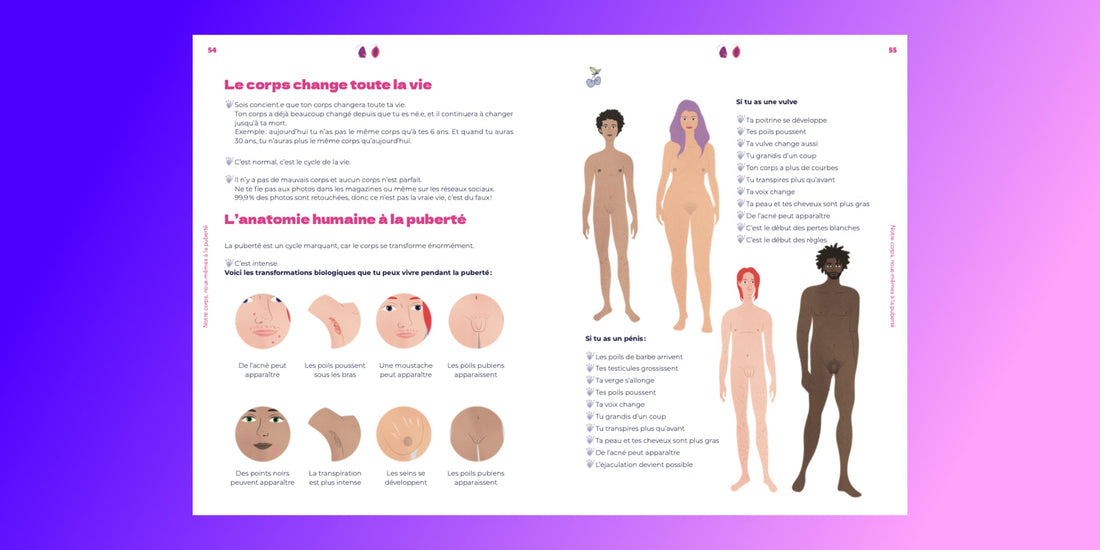
Discover the Ultimate Guide to Sex Ed: Everything You Need to Know
Share
Welcome to our blog dedicated to the book "The Little Guide to Sexual Pussy for Adolescents". The title may seem bold, but don't let the provocative appearance fool you. This book was created in a spirit of openness, humor and above all education.
Puberty is a time of major transformation in the life of every adolescent, whether a girl or a boy. It is a time when the body evolves, new sensations and questions arise, and we begin to explore our own sexual identity. In this book, we aim to demystify puberty, break down taboos, and offer accurate and caring information to help adolescents navigate this phase of their lives with confidence and understanding.
We'll cover essential topics like body changes, periods, sexuality, emotions, and much more. Our intention is to provide honest answers to questions teens have, encourage open communication between parents and children, and promote a healthy and respectful understanding of bodies and relationships.
Go directly to the book: The little guide to sexual pussy for adolescents by clicking on this link
Sex education is often a taboo subject, but it is essential to understand and be informed on the subject. Whether you're a parent, teenager, or just curious, this guide will provide you with all the information you need to navigate this important aspect of life.
In this article, we'll cover various aspects of sex education, including basic biology, healthy relationships, contraception, sexually transmitted infections, and consent. We'll give you practical advice, introduce you to available resources, and answer common questions to help you feel comfortable and informed about sexuality.
Whether you're looking for information about puberty, family planning, or intimate relationships, this guide will be with you every step of the way. Do not hesitate to explore the different articles to obtain all the answers to your questions.
Discover the book directly for adolescents by clicking on this link

The little guide to sexual pussy for teenagers
Get ready to explore the world of sex education in this comprehensive and informative guide. Be prepared to feel more confident and comfortable when it comes to talking about sex.
Sex education plays a crucial role in society, but it is often underestimated and devalued. It is essential to recognize the importance of providing complete and accurate information about sexuality to people of all ages. Sex education not only promotes healthy sexual relationships, but also helps prevent unwanted pregnancies, sexually transmitted infections (STIs), and sexual abuse.
By educating individuals about their bodies, sexual health and relationships, we empower them to make informed decisions and establish healthy boundaries. Sex education is an ongoing process that begins at a young age and continues throughout life. It is not limited to biology or the sexual act, but encompasses a wide range of subjects essential to a good understanding of sexuality.
Sex education is a broad term that refers to the teaching and learning of various topics related to human sexuality. It encompasses areas such as reproductive anatomy, sexual development, contraception, healthy relationships, communication skills, consent, sexual orientation, gender identity, and more. Sex education aims to provide individuals with accurate information, promote healthy attitudes and behaviors, and support responsible decision-making.
Sex education can be delivered in a variety of settings, including schools, community organizations, health care settings, and through online resources. It is important that sex education is age-appropriate, inclusive and comprehensive. By considering the diverse needs and experiences of individuals, sexuality education can effectively promote sexual health and well-being.
Julia Pietri, author of this ultimate guide for teenagers, explains that she wrote this guide thinking about the book she would have loved to have had at your age. An intimate book that really talks about things. In her time, it didn't yet exist and she had to wait a long time to get the answers to her questions.
For example, she discovered the true anatomy of her clitoris at age 30! You realize, it's late... She hopes that thanks to this book, new generations will be able to grow up with complete peace of mind and find answers, or at least food for thought, to all their questions.
This book exists because Julia Pietri is convinced that sexuality education is a crucial step in the development of our lives. This allows you to learn to know yourself better, to gradually let go of your complexes in order to live in good balance with your body, your head and your heart. An entire program!
Julia Pietri will address fundamental notions like love and friendship, but also talk about all possible romantic orientations, and talk about identity!
The concept of sex education has evolved over time, reflecting changes in societal attitudes and values. Historically, discussions of sexuality were often shrouded in secrecy and taboo. However, in the late 19th and early 20th centuries, pioneers of sex education began to advocate for more open and informed discussions about sexuality.
One of the first supporters of sex education was a woman! Her name is Dr. Mary Calderone. She co-founded the Sex Information and Education Council of the United States (SIECUS) in 1964. Calderone believed that sex education should be based on scientific knowledge and taught without judgment. Her work has paved the way for the development of comprehensive sex education programs that address the physical, emotional and social aspects of sexuality.
Comprehensive sexuality education has been shown to have many benefits for individuals and society as a whole. By providing accurate information about sexual health, relationships, and consent, comprehensive sexuality education helps individuals make informed decisions and develop healthy attitudes toward sexuality.
Studies have consistently shown that comprehensive sexuality education programs reduce rates of unplanned pregnancies and sexually transmitted infections among young people. These programs also contribute to the prevention of sexual violence and the promotion of gender equality.
In addition to physical benefits, comprehensive sex education promotes emotional well-being by encouraging healthy relationships, communication skills, and self-esteem. It also takes into account the specific needs and experiences of LGBTQ+ people, helping to create a more inclusive and tolerant society.
Despite the overwhelming evidence for the effectiveness of comprehensive sexuality education, there are still many misconceptions and misunderstandings about this topic. One of the most common misconceptions is that providing information about sexuality will encourage sexual activity among young people. However, research has consistently shown that comprehensive sexuality education does not increase the likelihood of sexual initiation or risky behaviors. On the contrary, it allows young people to make responsible decisions and engage in healthy relationships.
Another misconception is that sex education is solely the responsibility of schools. While schools play a crucial role in sex education, it is important that parents, health care providers, and community organizations also participate. Sex education is most effective when it is the result of collaboration between different stakeholders, which ensures that individuals receive consistent and accurate information.
A comprehensive sex education program should cover a wide range of topics in order to give individuals a comprehensive understanding of sexuality. Here are some of the key elements of a comprehensive sex education program:
1. Anatomy and physiology: understand the reproductive system, sexual development and the changes that occur during puberty.
2. Healthy Relationships: Teach individuals the characteristics of healthy relationships, including communication, consent, boundaries, and respect.
3. Contraception and family planning: Provide information on different contraceptive methods, their effectiveness and how to make informed choices regarding family planning.
4. Sexually transmitted infections (STIs): Educate individuals about common STIs, their transmission, prevention, and the importance of regular screening.
5. Sexual orientation and gender identity: Promote inclusion and meet the unique needs and experiences of LGBTQ+ people.
6. Media literacy: teaching individuals to critically analyze media messages related to sexuality and body image.
7. Sexual Violence Prevention: Provide information about consent, healthy sexual boundaries, and sexual violence prevention strategies.
Sex education should be adapted to the developmental stage and needs of individuals at different ages. Here are some guidelines for teaching sex education to different age groups:
1. Early childhood (4-8 years): Emphasize body knowledge, personal boundaries and appropriate touch. Teach basic concepts of reproduction and family diversity.
Julia Pietri also wrote a book for children (4-8 years): Here is the link to the early childhood book Click here
2. Middle Childhood (ages 9-12): Address the changes of puberty, including menstruation, body image and hygiene. Discuss friendships, feelings and healthy communication.
3. Adolescence (13-18 years): Provide comprehensive information on sexual health, contraception, consent, healthy relationships, and prevention of STIs and sexual violence.
To ensure sexuality education programs are effective, it is important to use strategies that engage learners and encourage active participation. Here are some strategies for effective sex education:
1. Interactive activities: Integrate role plays, group discussions and interactive exercises to encourage active learning and critical thinking.
2. Peer education: Involve peer educators who can relate to the experiences of their peers and provide a safe space for discussion and learning.
3. Inclusive language and materials: Use inclusive language and materials that reflect the diversity of experiences of individuals, including LGBTQ+ people and people with disabilities.
4. Parent Involvement: Involve parents and guardians in the sex education process by providing resources, workshops and opportunities for open communication.
5. Ongoing Support: Provide ongoing support and resources so individuals can access accurate information and support services outside of the classroom.
Go directly to the book: The little guide to sexual pussy for adolescents by clicking on this link





